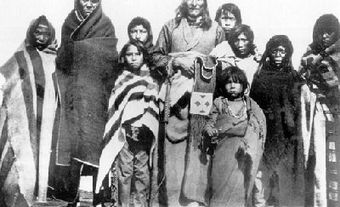Childhood, History of
Biology and the laws and customs of human culture together govern the nature of human childhood. The ways in which biology and culture come together in children change over time; the story of these changes forms the history of childhood. Human infants are born helpless and only gradually learn to care for themselves. In infancy and childhood they are vulnerable to a host of diseases; it is probable that until the 20th century at least one in 7 children born alive in Canada died during the first year. It is also probable that another one in 7 succumbed to disease during the vulnerable years from 1 to 7.
Children inherit possible patterns of growth from their parents, but these are realized in large part as a function of material conditions. Improved nutrition and living conditions have brought Canada closer than ever before to the optimal conditions for the physical growth of its children. In the mid-19th century, for example, some working-class boys did not reach their relatively short full growth until they were in their mid-20s. Today, Canadian children grow up faster, arrive at puberty earlier, pass through it more quickly, and achieve a greater final size than any preceding generation did.
Whereas biology makes all childhoods in some way similar, the customs and laws of each society make childhoods very different from each other in different places and in the same place at different times. The first child born in what is now Canada likely was born to people moving eastward along the shore of the Arctic Ocean over 30 000 years ago. Although we know nothing about childhood among these anonymous early settlers, we do know something about it among the native peoples who were their eventual successors. The children of Canada's native peoples had to learn the ways of complex societies. These ways differed from one language group or native nation to another at least as much as child-rearing practices differ between modern nations. An important dimension of native childhood was framed by the ways in which tribes sustained themselves; whether they were primarily hunters like the Blackfoot, farmers like the Huron or fishermen like the Kwakiutl, or whether they lived by a combination of fishing, gathering and hunting, like the Mi'kmaq.
On the central West Coast, for example, Kwakiutl lived in numaym, extended households of up to 100 people. Midwives assisted at births. Four days after birth the infant was given its first name, and it spent its first year in a cradle carried by its mother. At about a year the child acquired a new name, and boys had their hair singed and holes pierced in their ears and nose. High-status children were later given other names owned by the family, which parents saw as appropriate to their developing character. Families marked each new name with a POTLATCH gift-giving ceremony. Each numaym moved several times a year to one of the 5-7 resource sites owned by the chief. In a society highly conscious of property rights, children learned the precise locations of fishing and food-gathering sites and winter village locations. By observation and practice, children gradually mastered some of the skills employed at each site: making wood, stone, bone and metal tools; constructing longhouses, canoes and watertight wooden boxes; preserving and storing food; carving poles and masks; and weaving aprons, capes and blankets. The children of a SHAMAN (medicine man) submitted themselves to rigorous schedules, as they mastered the rituals, spells and dances owned by their families. The children of wealthy and well-born Kwakiutl learned the complex protocol of the potlatch and privately owned songs and dances, and learned to recite their family trees. All children learned the religious notions, mythology and taboos, and the workaday names and winter titles of those in their own numaym and neighbouring ones.
At puberty, a boy secluded himself and fasted before a ceremony at which he was given a name appropriate to his personal ability. A girl embarked on a complex regimen, governed by taboos and involving seclusion and periods of fasting.
Childhood among native peoples did not repeat itself exactly from generation to generation. When the Blackfoot acquired horses after about 1730, their way of life changed dramatically. Boys in particular had to learn new skills, rituals and taboos associated with caring for horses, and hunting and fighting bareback. Childhood in the various native nations changed again as various groups came into contact with European traders and settlers.
In New France mothers bore their children at home, assisted by a sage femme (midwife). Most infants were breast-fed by their mother or a wet nurse until about 14 months. Three or 4 days after birth the parents and godparents took the child to the nearest priest to be baptized. Children began their enfance swaddled or tightly bound. They slept in wooden cradles and were given rattles to play with. The average family in New France had 6 children. Some time before they were 7, children were thought to have begun to reason and therefore entered a stage known as tendre jeunesse. At about the same time they began to contribute to their family's welfare, at first through such tasks as looking after younger brothers and sisters, frightening birds from ripening crops and herding cows.
As they got older their parents added to their responsibilities. In a day that was usually full from daylight to dark, children rose to light the fires in the morning, emptied the chamber pots into the outdoor privy, brought in wood and water, swept floors and cleaned muddy boots. They cleaned stables and tended the stock. They helped seed and weed the garden, and in the late summer and fall they joined the whole family in the arduous task of harvesting. By adolescence most boys and girls had learned the household and farm skills. This competence was reflected in the fact that, theoretically, those who reached puberty (legally 12 for girls and 14 for boys) could be married. In practice, very few youngsters took this step. Growing maturity was recognized by all taking on increased responsibilities, and by boys being enrolled in the militia at 16 and beginning their indentures at about the same time. Although most waited till age 25 for marriage (the mean age of marriage between 1700 and 1730 was 22.4 for women and 26.9 for men), a person became a functional adult in New France at about age 20. The push to maturity was probably hastened by high mortality rates, which ensured that half the adolescents in the colony had only one living parent.
In the late 18th and early 19th centuries childhood among the Loyalists and later anglophone settlers was very similar to that described for New France; children were needed and highly valued for the work they did. Since they could be easily fed and clothed from the produce of the household, they were soon an economic asset rather than a liability. Travellers commented that Canadian children of both French and British background tended to be more independent and self-reliant than their European counterparts.
In the 19th century schooling became a dominant childhood experience. Around 1800 only a small number, mostly boys, had much formal education. By 1900, most children attended publicly supported schools for a few years, and many attended consistently between about 5 and 16 years of age. One reason for this change was that Canadian children became the beneficiaries of new attitudes emerging in western Europe and North America, which saw childhood as a stage of life in which greater protection, sheltering, training and education were necessary. Although this change in attitude affected all children, we see evidence of it first in the care of dependent children. Canadians began to build special institutions to care for orphans and for children whose parents could not care for them. Changing economic conditions accompanied changing attitudes to children. Thus children attended school because maturity and compactness of settlement, improved roads, etc, made it easier for them to meet for schooling; because mature farms could more easily spare youngsters for at least part of the year to go to school; and because parents came to see that education was increasingly useful in a society in which commerce and then industry became important. Parents recognized that, for many jobs, literacy was becoming a practical necessity rather than an ornament.
The growth of cities and industries changed the rhythm of the seasonal cycles of farming, fishing, lumbering and trapping. The home ceased to be the primary place of production. A rising standard of living permitted families to devote more of their incomes to improving the quality of their lives. They moved to larger houses, they ate better food and lengthened the period of time that they kept their children out of the paid workforce. With fathers now away for the customary 60-hour work week, mothers who stayed at home had to assume most of the responsibility for raising the youngsters over this longer period of dependency.
Improved child rearing and child care became public concerns. By the 1920s in anglophone Canada (perhaps a little later in francophone Canada) new social policies and programs had been created for children. Social activists tried first to bolster families who were already doing a reasonable job of raising their youngsters. In their public health work they tried to increase the chances of survival of all children. They strove for an educational system which, in addition to teaching the traditional three Rs, would also prepare girls to be better housekeepers and mothers, and boys to be sober, honest, well-trained and industrious breadwinners and fathers. Reformers tried to improve the physical and social environment of homes and schools; they set aside and began to supervise playing-fields and parks, and supported such new organizations as the Boy SCOUTS and GIRL GUIDES.
The social reformers also tried to help children and families with special problems. So that reluctant families and young people would take advantage of the school system, they pressed for the regulation of CHILD LABOUR, compulsory school attendance and the appointment of truant officers. To prevent families from breaking up as a result of the death or incapacitation of the father, they campaigned for workers' compensation and mothers' pensions. Factory Acts and antisweating legislation were introduced to protect the health of working-class mothers and their children, and a few DAY CARE operations were started. At some schools milk or hot lunches were provided, and "fresh air" funds were begun to take poor children and their parents out of their environment once a year.
Social reformers also tried new ways to salvage youngsters whose families would not or could not rear them. They began to question the merits of children staying for long periods of time in the institutions built in the 19th century. Canadians gradually ended the grim practice of "baby farming." They began ADOPTION services to place illegitimate babies in family homes rather than in foundling institutions and to legitimize children whose parents subsequently married. Socially conscious legislators shifted the care of vagrant, orphaned, neglected, dependent, "incorrigible" and delinquent children from institutions to families (see JUVENILE DELINQUENCY). They passed the Federal Juvenile Delinquents Act and set up a system of juvenile courts, detention homes, and probation officers to deflect youthful delinquents from crime. Between the 1920s and the 1970s, Canadians strove to put all of these programs into effect and to bring them to bear on the lives of all children in the country.
See also CHILD ABUSE; CHILD WELFARE.

 Share on Facebook
Share on Facebook Share on X
Share on X Share by Email
Share by Email Share on Google Classroom
Share on Google Classroom


